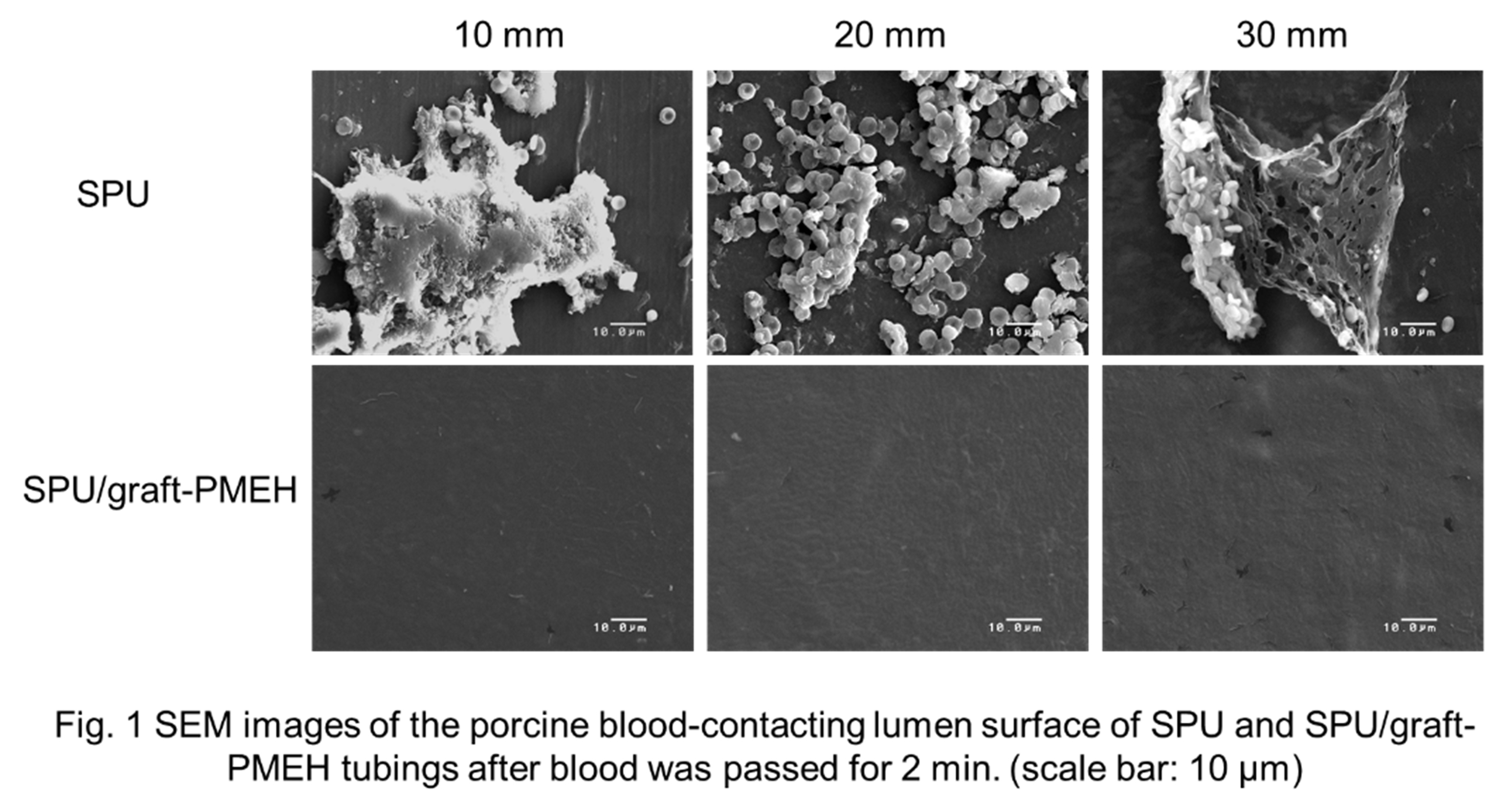Introduction: The foreign surfaces of cardiovascular biomedical devices always cause blood coagulation. The adherent endothelial cells protect the surfaces of synthetic vascular prostheses with diameter over 6 mm from blood coagulation. However, the applications of these vascular prostheses as small arteries (diameter: less than 2 mm) were failure due to limited thrombogenicity.The objective of this study is to develop an antithrombogenic surface modifier of the segmented polyurethane (SPU) by the graft-type 2-methacryloyloxyethyl phosphorylcholine (MPC) polymers. The SPU is widely used as biomedical materials because of its excellent mechanical properties. To achieve molecular interaction between MPC polymer and SPU even under the blood flow condition, the graft-type poly(MPC-co-2-ethylhexyl methacrylate (EHMA)) (graft-PMEH) was synthesized and hybridized with the SPU [1]. The affinity between poly(EHMA) segments and soft segments of SPU is a key intermiscibility in the SPU/graft-PMEH. Initial blood interactions were observed by passing through the SPU/graft-PMEH tubing [2].
Materials and methods: The graft-PMEH was synthesized by two different living radical polymerizations. The SPU/graft-PMEH membrane was prepared by a double-solution casting procedure. The surface elements of membranes were confirmed by X-ray photoelectron spectroscopy (XPS). Biocompatibility was evaluated by protein adsorption test from human plasma with gold-colloid labeled immunoassay, and human umbilical vein endothelial cells (HUVEC) adhesion assay. The SPU/graft-PMEH tubings (Φ2 mm, length 35 mm) were prepared with the similar procedure of membranes on a revolving stick. The tubing was directly connected to the living porcine blood vessel for 2 min. The samples were observed by scanning electron microscopy (SEM).
Results: The phosphorus peak and nitrogen peak attributed to phosphorylcholine group of MPC unit were observed on the XPS in SPU/graft-PMEH membranes. Plasma proteins adsorbed in a dispersed pattern on the SPU surface. In contrast, the SPU/graft-PMEH membrane dramatically suppressed 90% amount of protein adsorption. Also, a little HUVEC could be adhered and no proliferation was observed. On the luminal surface of SPU/graft-PMEH tubing, blood cell adhesion was inhibited even after whole blood was passed through without anticoagulation (Fig.1).

Discussion: The graft-PMEH shows a high stability on the SPU surface because that poly(EHMA) segments side chains promote intermiscibility with the soft segment domain of SPU. The graft-PMEH could prevent thrombus formation even after blood contacting without any anticoagulant. This is due to the nature of the MPC polymers, that is, high resistance to adsorption of proteins and adhesion of cells to obtain antithrombogenicity.
Conclusion: The SPU/graft-PMEH combined with excellent blood compatibility, mechanical properties and non-endothelialization is a potential biomaterial for small diameter vascular prostheses.
We would like to thank Dr Tomohiro Konno and Dr Kyoko Fukazawa from the University of Tokyo for their valuable and constructive discussions.; This work was financially supported by a Health and Labour Sciences Research Grant (Grant H24-018) from the Ministry of Health, Labour, and Welfare of Japan.
References:
[1] Yihua Liu, Yuuki Inoue, Sho Sakata, Sachiro Kakinoki, Tetsuji Yamaoka, Kazuhiko Ishihara. Effects of molecular architecture of phospholipid polymers on surface modification of segmented polyurethanes. J. Biomater. Sci. Polym. Edn., 25(5), 474-486, 2014.
[2] Yihua Liu, Yuuki Inoue, Atsushi Mahara, Sachiro Kakinoki, Tetsuji Yamaoka, Kazuhiko Ishihara. Durable modification of segmented polyurethane for elastic blood-contacting devices by graft-type 2-methacryloyloxyethyl phosphorylcholine copolymer. J. Biomater. Sci. Polym. Edn., 25(14-15), 1514-1529, 2014.